Can You Make Money On Android Apps With Firebase
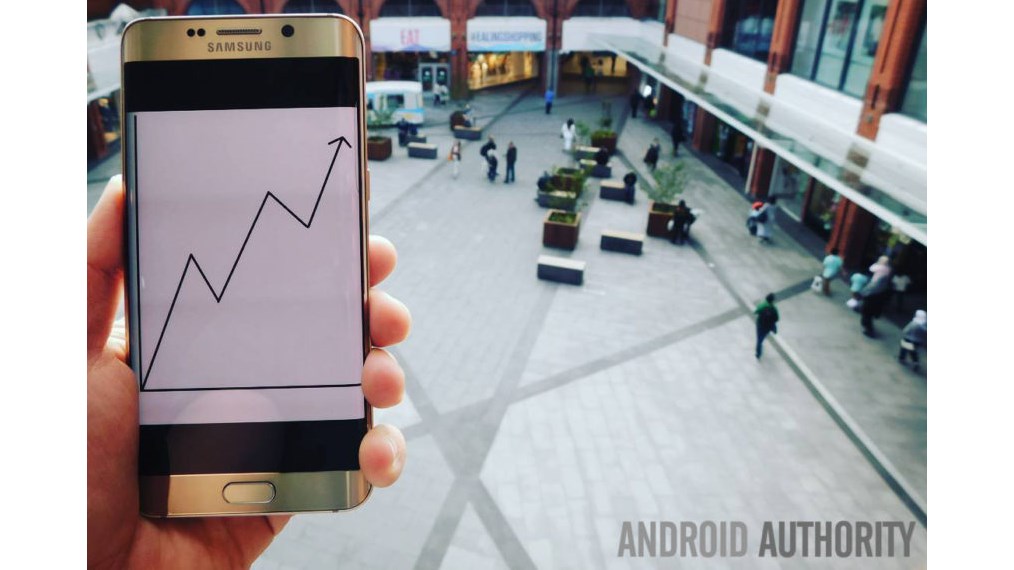
These days, more and more app developers are eschewing the pay-to-download business model in favor of making money from their creations in other ways. This is particularly truthful on Android, where users are highest in number but not quite and so keen to dig deep for their favorite apps (compared with iOS users).
AdMob is one alternative option bachelor to those developers. This is a class of PPM advertising, which means 'Pay Per Impression' and that ways you get paid just by displaying ads on top of your app content. AdMob is the biggest platform of its kind on Android, which is no surprise seeing as it is owned by Google. Let's take a expect at just how it works, how to fix information technology up and whether or not information technology'south right for you lot.
How AdMob works

Monetizing with ads allows you to attract more than downloads by keeping your app costless but this also means you need a very actively engaged audience that will use your software regularly if you're going to make any serious money. This is because the profits you lot make from AdMob are straight tied to the number of views and clicks the ads receive. This is why information technology is referred to as 'Pay Per Impression'; each fourth dimension your ad is displayed and seen by a user, that counts as an 'impression' and will contribute to your overall earnings. If your app gets downloaded in one case and never used again, yous're non going to earn much at all.
The precise amount of money that a click or impression gets you will depend partly on what kind of ad you choose. When setting upward, you'll have 4 dissimilar types to choose from:
- Banner ads
- Interstitials
- Rewarded interstitial
- Native ads
Banner ads are elementary banners that can appear over the top of your content. These are less intrusive because the user can bear on with what they're doing. Generally, they volition encourage your users to try other apps or products. When the user taps the ad, information technology will expand to fill up the screen. Banner ads can come in a diverseness of sizes, to suit your UI.

Interstitials on the other hand are always full-page and volition ordinarily be inserted at natural break points in your app. So if your app focuses on written content, then your ad might show after several pages every bit the user transitions from 1 screen to the side by side. Alternatively, a game might place interstitial ads between levels, or when the thespian dies and respawns.
Rewarded interstitials meanwhile are videos that reward y'all for watching them. Many games for case will let y'all watch the advertizing in order to proceeds extra lives or attempts at a level. Finally, native ads are ads that are better integrated into the app itself and that fit into your UI. And so if y'all had a list of images, an advertisement might be seamlessly inserted betwixt two of them every bit users scroll through.
Choosing the correct type of ad that is noticeable but not frustrating, is a big office of winning at AdMob!
How much volition you earn?
And so how much can you expect to make from AdMob? The reply of grade depends on how popular your app is merely suffice to say that it starts out pretty pocket-size, and so yous shouldn't go into this thinking it'south guaranteed to exist your big pay day!

Nope
Revenue from AdMob is calculated as eCPM. That stands for 'Effective Cost Per (thousand) Impressions', which means on boilerplate, you are making that effigy from 1,000 views. This takes into account both your PPM (Pay Per grand Impressions) and your PPC (Pay Per Click). You tend to get paid a chip more than when a user actually clicks on an advert just of course this happens less oftentimes (this metric is known equally CTR or 'Click Through Rate'). eCPM gives you a useful single effigy that estimates just how much you can expect to get paid when you accept X corporeality of people using your app for T amount of time.
And then what is an boilerplate eCPM? Over again, this comes down to several factors simply merely to requite you a very crude idea, something in the region of $0.15-$4 could exist considered fairly normal for Android banners, while you might make well-nigh $ii-$10 for interstitials. It's very hard to find whatever useful data on this subject though, with these estimates existence based on my research trawling forums besides as my own (limited) experience. There's certainly a lot of variation between developers though.
Likewise, the position of the adverts and nature of the app can also impact on how likely someone is to click it.
So why the variation? It depends on a huge number of factors. For starters, the actual amount advertisers pay for clicks or impressions will vary based on the amount of competition. Advertisers actually bid for ad spaces in an automatic manner similar to eBay, significant that they only take to pay the minimum amount necessary to crush the contest. The more people are competing for a spot on your ad, the higher the PPM and PPC.
As well, the position of the adverts and nature of the app tin also impact on how probable someone is to click it, which can drive your PPM up or down. Then in that location are regional differences, with sure markets paying a lot more others. And finally, sometimes an odd day can throw your statistics mode off. If you have a slow day with 5 impressions merely they all become clicked and coincidentally have high payouts, then that information will be extrapolated to summate the average eCPM as existence very high. You lot really need a few thousand impressions before the data is reliable.
But, it suffices to say that some people are earning thousands of dollars per month from AdMob, while a lot of 'average' developers are getting peanuts. In short, you need your app to be a pretty big hitting in gild for AdMob to make you rich. But by removing the toll tag for downloading your app, you lot increment the chance of this happening.
How to prepare-up AdMob
The adept news is that AdMob is piece of cake to effort out if you decide you want to give it a go. Outset, you'll demand to set up an AdMob account. You can practice this here and if y'all already have a Google account, so yous tin just utilise that.
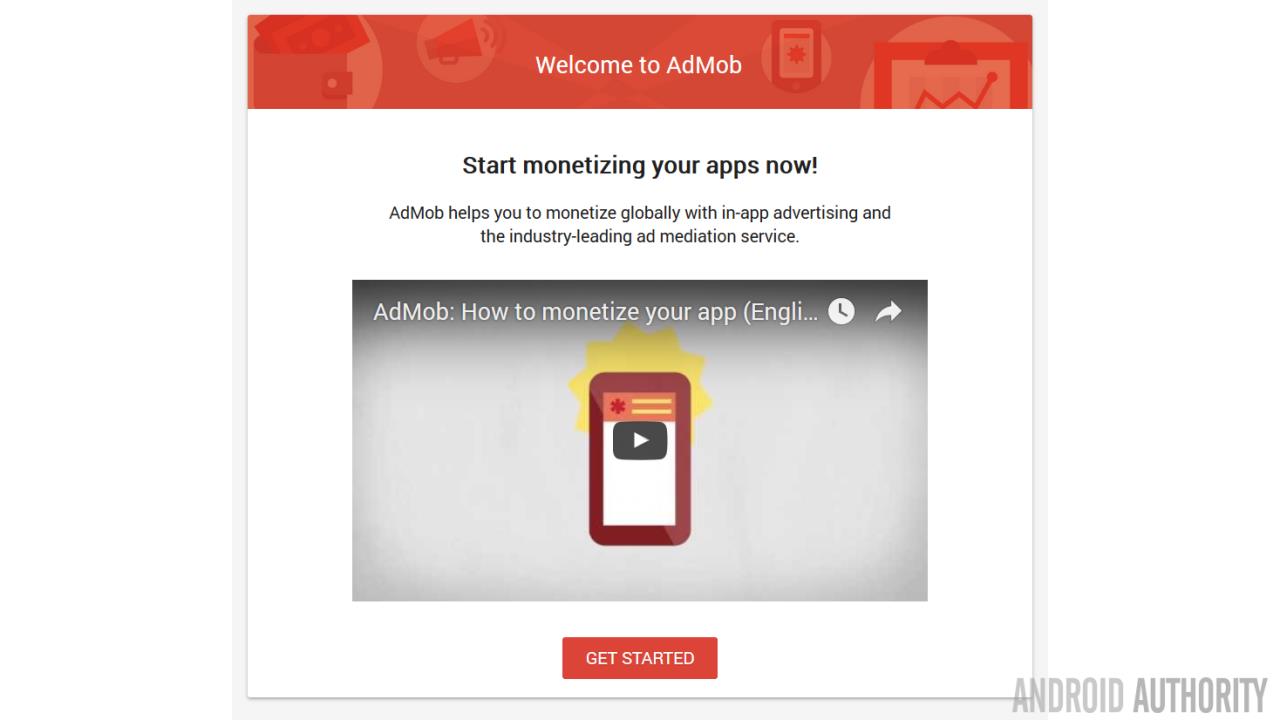
Go through the few like shooting fish in a barrel steps and and so yous'll be able to make it to the main dashboard. From here, yous'll then be taken through the process of creating your first advert. Simply search for your developer name using the search bar provided and and then select the app you wish to try monetizing. If you want to ad an app you haven't published still for testing purposes, then you can do this past selecting to add your app manually and and so entering the package name. You tin can then choose if you want to use a banner add, interstitial, rewarded interstitial or native ad.
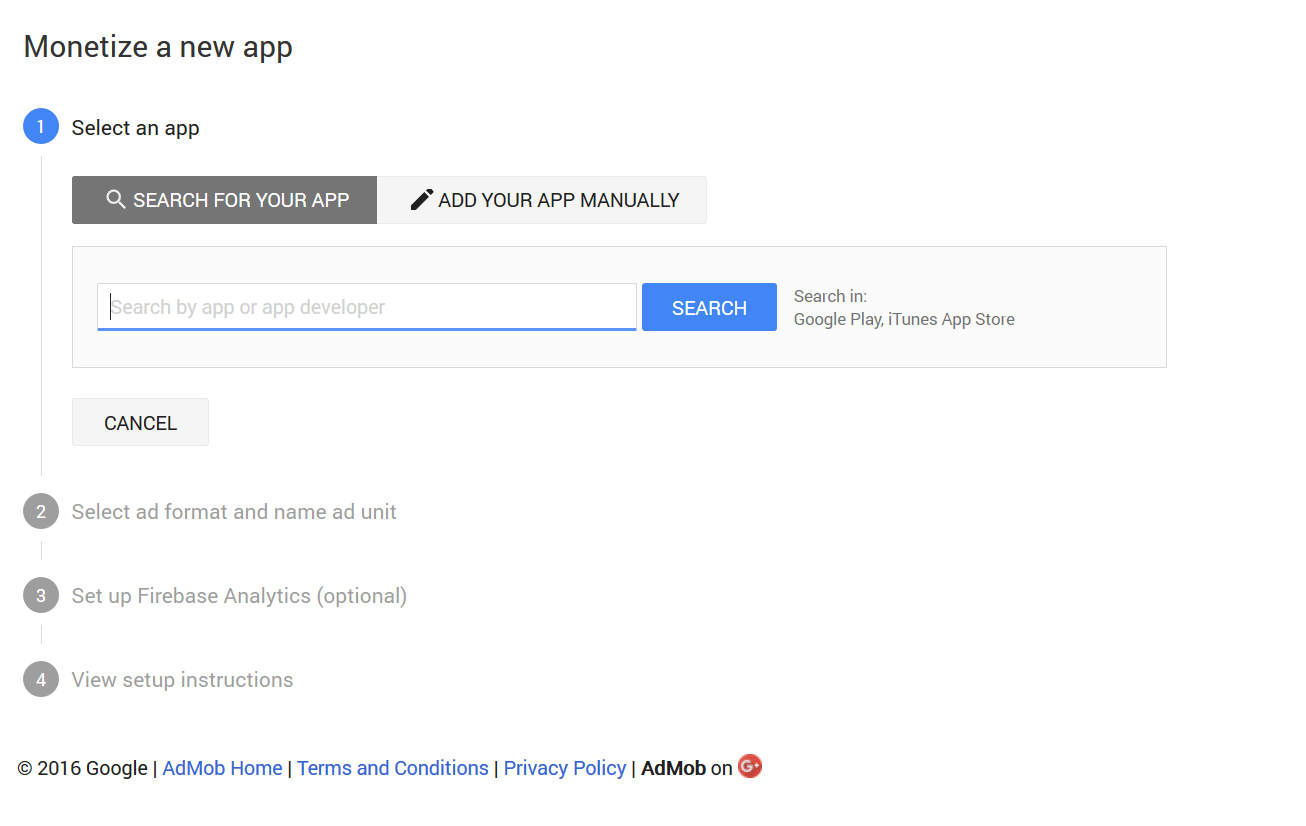
Depending on what type of ad yous choose, you're at present going to be given various options – whether you desire to show text only, or images also, for case. You'll also exist able to proper noun your advertizement unit, which is simply for your own management and tracking later on.
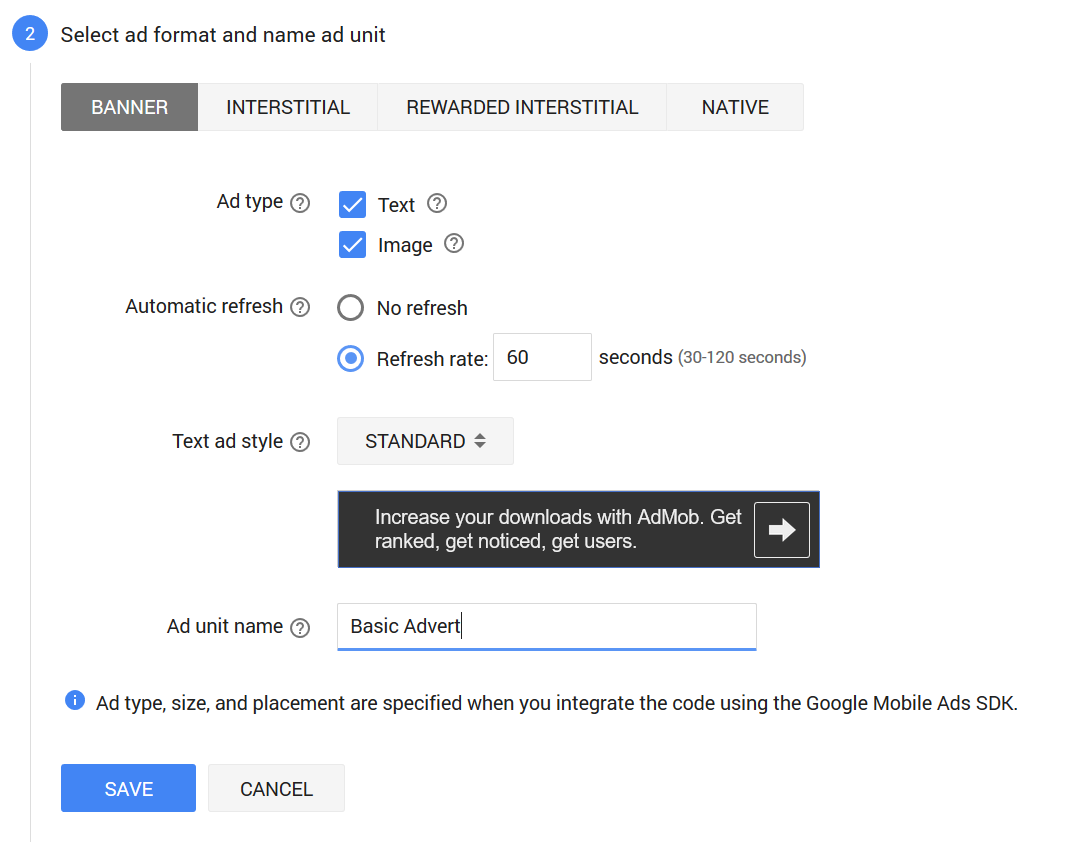
The refresh rate is important here because it defines how often new ads bear witness, increasing the number of impressions that y'all can get from a single session. You lot shouldn't make this faster than 60 seconds though and annotation that it can be very distracting if your ad keeps changing!
Adjacent, you can opt to link your app data to Firebase and you should go ahead and practice that. This is basically a deject service that provides more advanced data for AdMob amidst other things (information technology also offers features like push notifications and crash reporting). We've covered how you can get to know your audience ameliorate with Firebase Analytics before and you tin watch the useful but cheesy video from Google here. The good news is that if yous don't already have a Firebase business relationship, Google will prepare one up for you automatically. You can also add a project to Firebase via your Google Analytics account by clicking 'Get Started With Firebase' which is found in the summit right.
Firebase is optional and at the moment it is still possible to use AdMobs with just the Google Play Services. Yet, Google is pushing the Firebase pick correct now, so this is probably the road you should take to ensure you'll be future-proof. The adept news is that the Firebase route is too pretty easy. Y'all'll need to download the Firebase Config file (Called Google-Services.json) and the link will exist shown to you lot as soon as you've selected to use Firebase.
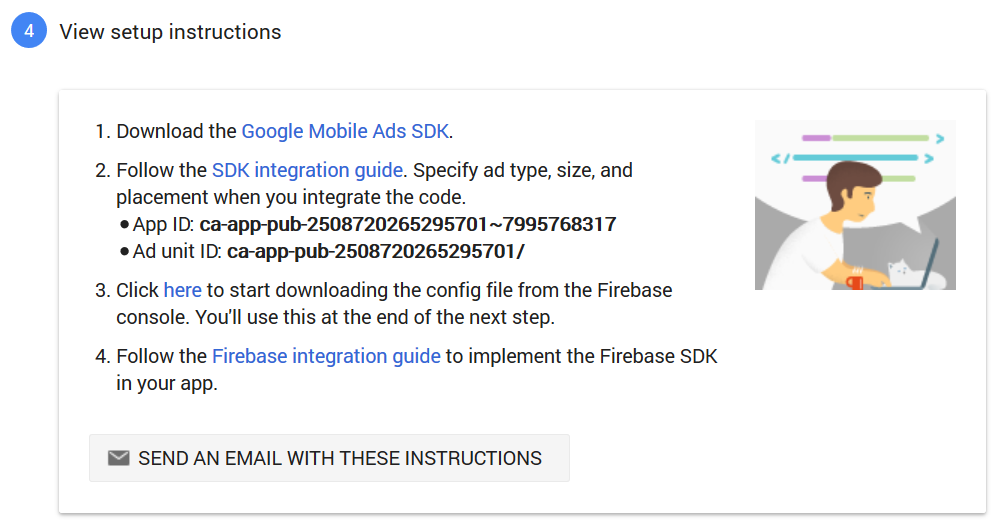
You lot can so just driblet that file into the app directory of your app project. This is of import because Android Studio will exist looking for it at build. Note that yous demand to generate unique files for each app yous create and you lot can't merely keep using the aforementioned one as they include the bundle name!
Now you'll need to load upward Android Studio then that you can go to the project level build.gradle file of your app. Here, you're adding the dependency:
Code
classpath 'com.google.gms:google-services:three.0.0' Now head to the app levelbuild.gradle and add together a line to apply the plugin:
Code
apply plugin: 'com.google.gms.google-services' Then y'all can simply add together the individual services you desire as dependencies in that same file. We want to utilize AdMob in this instance and so we use:
Code
compile 'com.google.firebase:firebase-ads:9.0.ii' Let Gradle practice a sync and you lot should now be all ready to get and showtime actually calculation the ads into your code!
(P.Southward. What they don't tell you in the official documentation is that you also need add net permission to your manifest file, like then: <uses-permission android:proper name="android.permission.INTERNET" />. Android studio will prompt y'all should you forget.)
Inserting your adverts
Once you have the AdMob SDK all ready and ready to go, y'all can showtime inserting adverts into your apps. This varies depending on what type of ad you desire to use and there's no point in united states of america repeating what's in the documentation here, and then equally an example let'due south just look at banner ads.
To begin inserting banner adverts, you lot'll starting time demand to create a new string in your Strings.xml. That string is going to provide your ad unit ID so that you can easily change information technology later.
Code
<cord proper name="banner_ad_unit_id">Advertisement Unit ID Hither!</string> Y'all can get this ID from your AdMob dashboard:

At final, y'all tin add together the banner in your XML with:
Lawmaking
<com.google.android.gms.ads.AdView android:id="@+id/adView" android:layout_width="wrap_content" android:layout_height="wrap_content" android:layout_centerHorizontal="true" android:layout_alignParentBottom="true" ads:adSize="Imprint" ads:adUnitId="@string/banner_ad_unit_id"> </com.google.android.gms.ads.AdView> 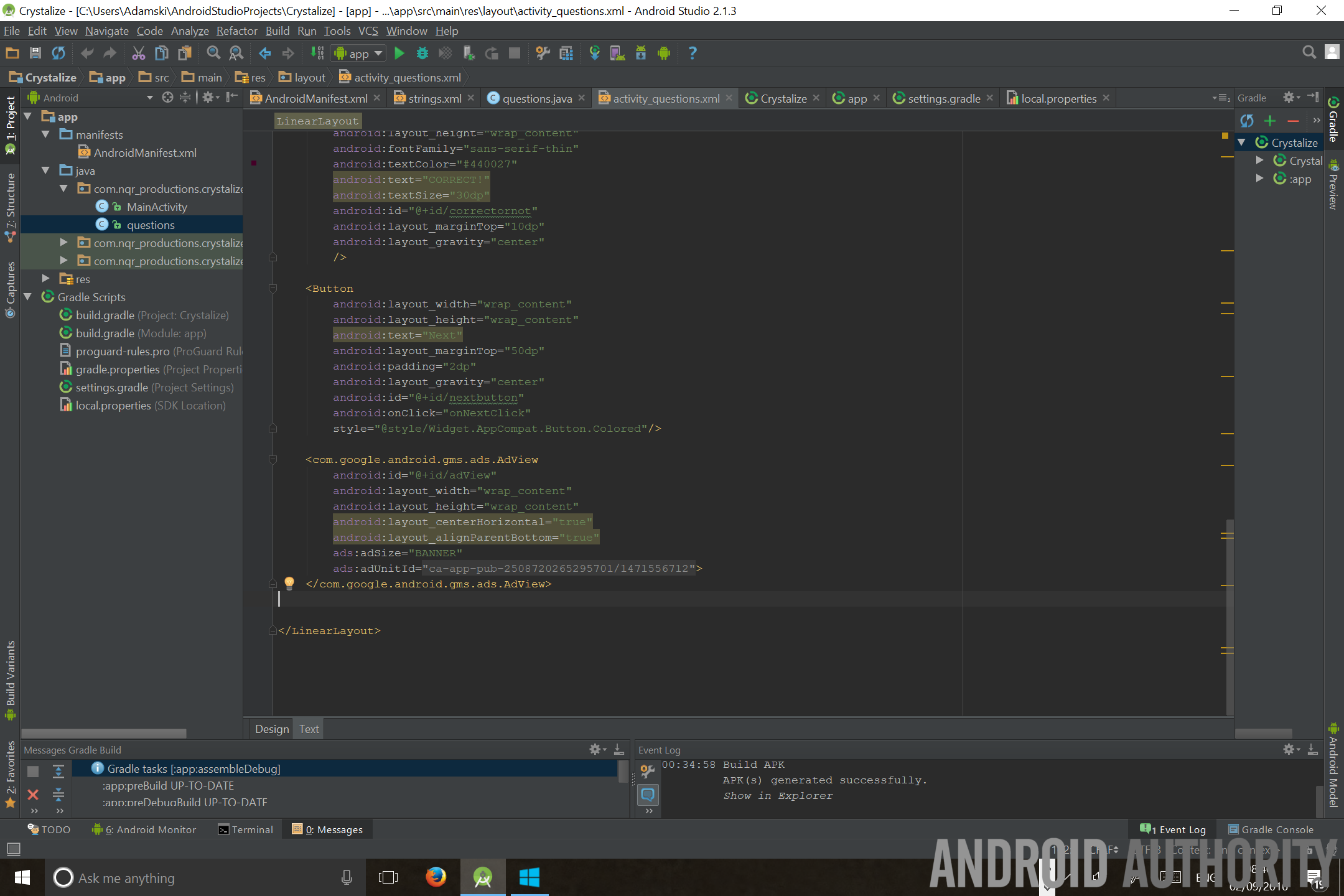
Don't forget to add an extra namespace at the top besides:
Code
xmlns:ads="http://schemas.android.com/apk/res-auto" Finally, yous'll need to insert a couple of lines into your activity'south Coffee file. First, you need to initialize the SDK at app launch past placing information technology in onCreate:
Code
MobileAds.initialize(getApplicationContext(), "YOUR APP ID"); Find your app ID past clicking on 'App management' which is found in the settings card of your AdMob control panel.

Finally, yous demand to load an advertising into the AdView you lot created in your XML. You practise this past calculation two more than lines of code in your onCreate:
Lawmaking
AdView mAdView = (AdView) findViewById(R.id.adView); AdRequest adRequest = new AdRequest.Builder().build(); mAdView.loadAd(adRequest); 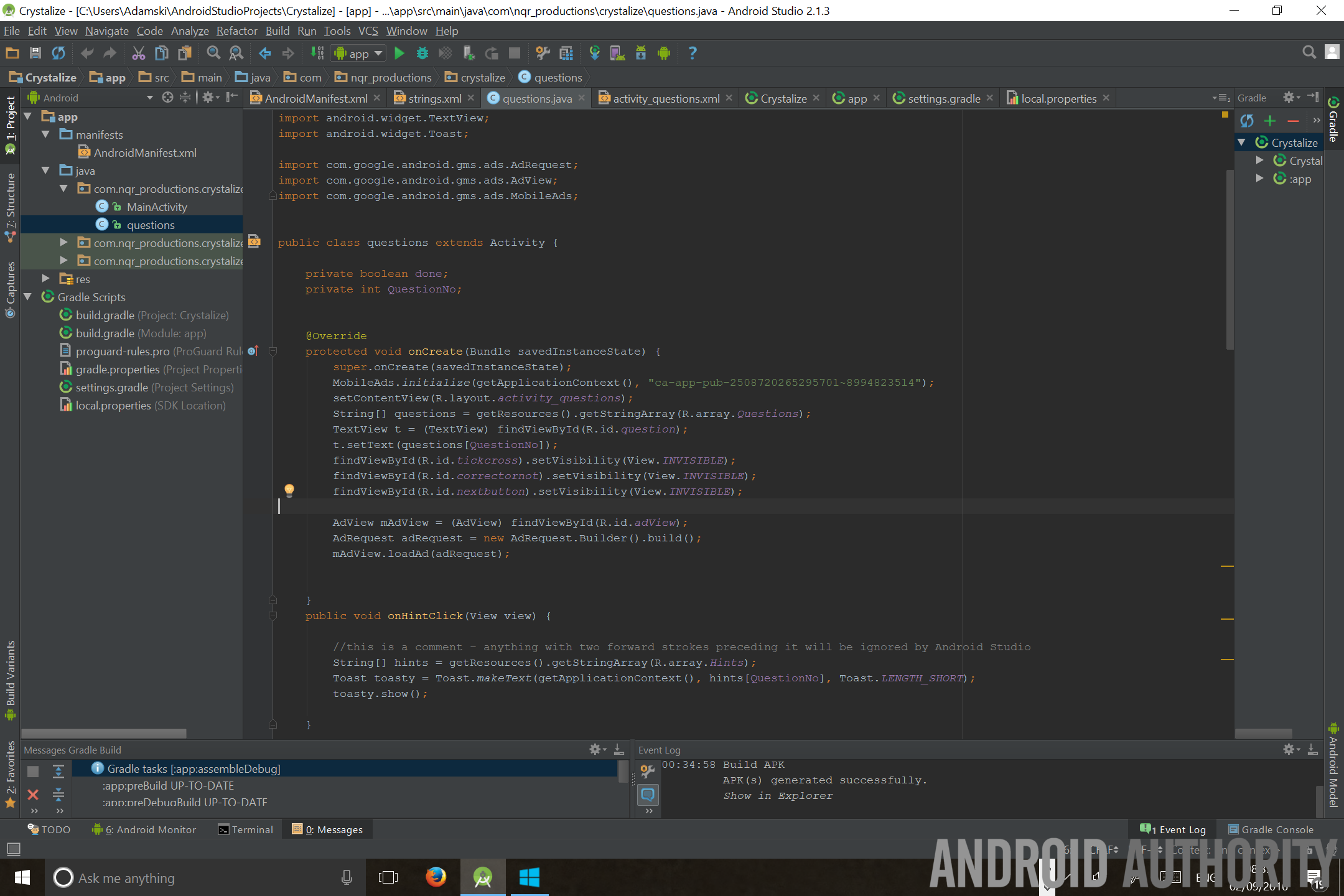
It sounds like a lot but if you get through each footstep in sequence, and then it's something you'll only really need to do once and and so you can forget all almost information technology! That said, you can get more technical by tracking your ad lifecycle events such as 'onAdLoaded' or 'onAdClosed' and you can notice details on that hither. You'll set this up with an AdListener simply if you lot'd rather not, it's entirely optional.
If you lot recall the Crystalize app we fabricated in a previous tutorial, this is what it should look similar with a banner advertizing added:
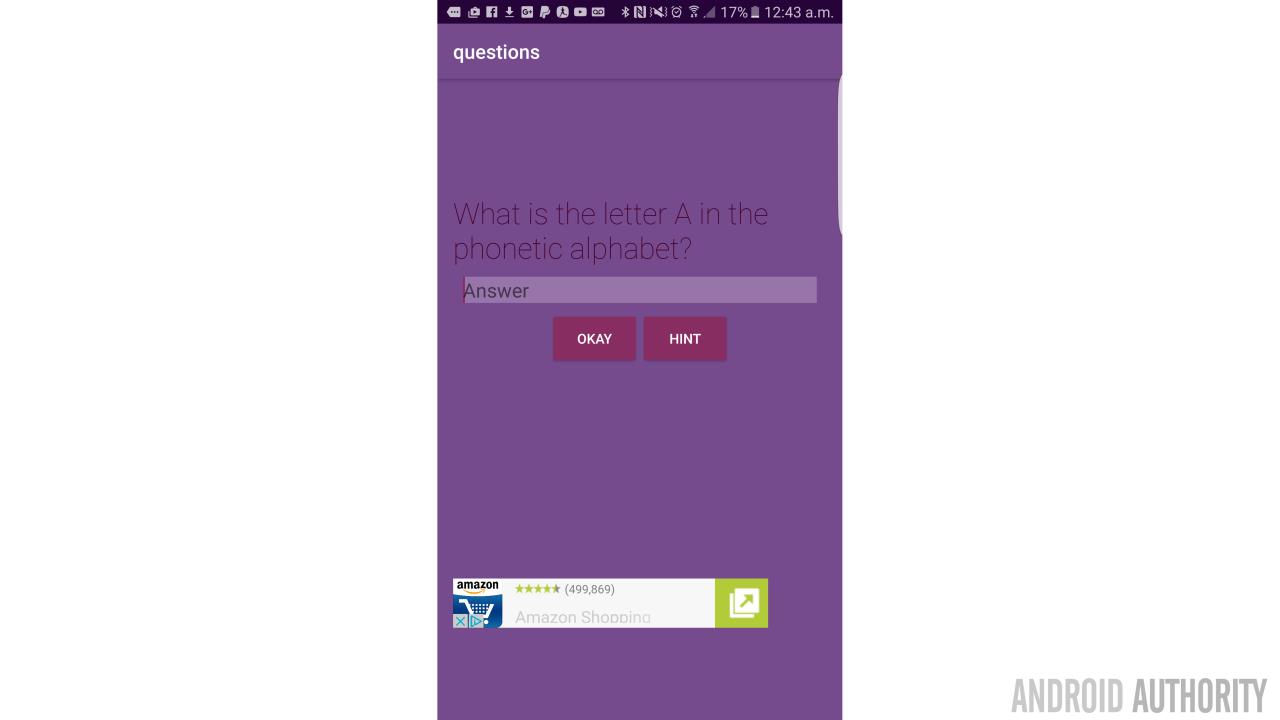
So how well-nigh Interstitial Ads and Native Ads? These are a piffling different but thankfully, Google has provided detailed steps for inserting these likewise. Bank check them out here. It's fairly intuitive one time you offset understanding the way AdMob works. Plus, it uses the fun tongue-twister 'instantiate the interstitial', so you can look forrard to that!
Remember that if you lot're experimenting and your app isn't live, so you should use Exam Ads rather than regular ads. This is intended to prevent yous from accidentally generating your own clicks and thereby risking getting booted off of the platform!
At this bespeak though, you should exist ready to start tweaking your placement and settings to see how that furnishings your profits. It tin can accept a fiddling while to get information technology all just right but it'south fun experimenting forth the way and who knows, it might but lead to a nice fiddling windfall!
When AdMob makes sense
And then should you use AdMob? And what kind of app can benefit about from the platform?
The thing to remember here is that user engagement is crucial. If your app is a 'in one case use' kind of thing, then you just aren't going to become the impressions, even with hundreds of thousands of downloads. In that case, you're better of charging per download. On the other hand though, if your app is a highly addictive game that you remember users volition want to sink a good amount of time into on a daily ground, or if it'due south a tool that they're going to need to use often, then suddenly AdMob makes a lot more sense.
It tin have a little while to get it all just right but it's fun experimenting forth the way and who knows, it might just atomic number 82 to a overnice little windfall!
In short, you tin can make money from paid downloads thanks to the impulsive nature that leads many people to make purchases. Just if your app has real staying ability, then ultimately that will evidence to be a limited business model and AdMob could be making you more.
Of course you also need to deport in heed that users can notice ads irritating and that this tin harm your user experience. How willing your audience is to put up with this inconvenience is going to depend very much on the type of app and who information technology is aimed at. But once again, this is where experimentation is cardinal – and past trying out different refresh rates, different types of ad, different banner sizes etc., yous may just find it'south possible to settle on something that isn't too in-your-face merely still manages to go you a off-white amount of impressions and clicks.
Then all that's left to practise is promote the heck out of your app!
Source: https://www.androidauthority.com/use-admob-to-monetize-your-app-714339/
Posted by: martinezishaves.blogspot.com

0 Response to "Can You Make Money On Android Apps With Firebase"
Post a Comment